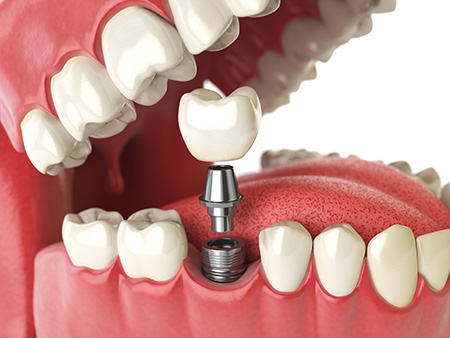
Three million people in the United States currently have dental implants, and every year that number increases by about 500,000.
But, for some, getting a dental implant is not the end of the story. Similar to what occurs with a natural tooth, bacteria can build up on the implant’s base and below the gum line. Over time, the bacteria can cause peri-implantitis, a condition that can eventually lead to the loss of soft and hard tissue (gums and bone) surrounding the implant.
It’s a condition that typically requires surgical intervention.
Implants were originally designed for a small population, and they were considered experimental, Professor Malcolm Snead says. “There has been a major change in the way dentists use implants, and now implants are widely used to replace teeth with a poor prognosis.” However, the implant is just as susceptible to biofilm formation and the patient’s immune response, which attempts to limit the infection but also leads to the loss of supporting hard and soft tissues.
A minimally invasive approach
Even so, implants are here to stay, and that’s why Snead and two other Ostrow researchers — Professor Casey Chen and Research Assistant Professor Yan Zhou, along with Professor Candan Tamerler, a collaborator at the University of Kansas — took on research to create a bifunctional peptide film. This non-surgical intervention is applied in water and can be repeatedly applied to existing implants to reduce bacterial growth. The study, called “Repeatedly Applied Peptide Film Kills Bacteria on Dental Implants,” was published last month in the Journal of the Minerals, Metals and Materials Society.
This is how it works: Snead and his colleagues created a peptide (a short chain of amino acids) that binds to titanium and hung different antimicrobial peptides off this anchor — making a film that kills bacteria, targets the worst pathogens and hopefully reduces the speed of biofilm build up. The therapeutic peptide film could be applied in a dentist’s office but could also work at home, if the FDA approves it for such a use.
“Sniper, not nuclear bomb”
Snead says the implant-protective film would be a water-based rinse, and a patient would swish it around and spit it out.
Right now, some people have to go on low-dose antibiotics to stop the bacteria from building up on their implants, but a focused rinse could be much more targeted.
“It’s a sniper rather than a nuclear bomb,” he says, adding that multiple applications could give patients extra years of service from an implant.
The group hopes to refine these peptides, go to FDA safety testing, and then move to large animal models for testing.
Bigger ambitions
Eventually, Snead has a much bigger audience in mind: anyone with periodontal disease, one of the world’s most prevalent infectious diseases.
“Our real goal is to be able to anchor antimicrobials on the tooth’s mineral component and create an antimicrobial environment just by brushing,” he says. “Doing that would hopefully reduce the amount of periodontal disease in the patient population.”
He likens this initial work on implants to Tesla’s strategy of developing better batteries so their cars can go longer and father. “By attacking the implant surface, we get the potential of developing a set of tools and molecules that could be applied to everyone’s teeth.”
